Edges of His Ways, by Amy Carmichael

Every morning I read Edges of His Ways: Selections for
Daily Reading, from the notes of Amy Carmichael, who was a missionary in
South India from 1895 until her death in 1951. She read scripture (many
translations), and shared her ponderings throughout the years. Her writings
helps keep my faith alive and dynamic. I also appreciate and am strengthened by
language of the day in which she wrote.
Here is an entry that continues to challenge me. It is in response to Luke 22:50, 51: And one of the them smote the servant of the high priest, and cut off his right ear. And Jesus answered and said, suffer ye thus far. And He touched his ear, and healed him.
“The last thing the Lord Jesus did before His hands were bound was to heal.
“Have you ever asked yourself, If I knew that this was the last thing I should do, what would I do? I have never found the answer to that question. There are so very, very many things that we would want to do for those whom we love, that I do not think we are likely to be able to find the chief one of all these. So the best thing is just to go on simply, doing each thing as it comes as well as we can.
“Our Lord Jesus spent much time in healing sick people, and in the natural course of events it happened that the last thing He did with His kind hands was to heal a bad cut. (I wonder how they could have the heart to bind His hands after that.) In this, as in everything, He left us an example that we should follow in His steps. Do the thing that this next minute, this next hour, brings you, faithfully and lovingly and patiently; and then the last thing you do, before power to do is taken from you (if that should be), will be only the continuation of all that went before.”
.
Here is an entry that continues to challenge me. It is in response to Luke 22:50, 51: And one of the them smote the servant of the high priest, and cut off his right ear. And Jesus answered and said, suffer ye thus far. And He touched his ear, and healed him.
“The last thing the Lord Jesus did before His hands were bound was to heal.
“Have you ever asked yourself, If I knew that this was the last thing I should do, what would I do? I have never found the answer to that question. There are so very, very many things that we would want to do for those whom we love, that I do not think we are likely to be able to find the chief one of all these. So the best thing is just to go on simply, doing each thing as it comes as well as we can.
“Our Lord Jesus spent much time in healing sick people, and in the natural course of events it happened that the last thing He did with His kind hands was to heal a bad cut. (I wonder how they could have the heart to bind His hands after that.) In this, as in everything, He left us an example that we should follow in His steps. Do the thing that this next minute, this next hour, brings you, faithfully and lovingly and patiently; and then the last thing you do, before power to do is taken from you (if that should be), will be only the continuation of all that went before.”
.
Mountain of Silence, by Kyriacos C. Markides
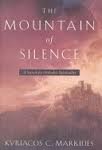
Kyriacos C. Markides, The Mountain of Silence: A Search for Orthodox Spirituality. Random Houe, 2001.
Quotes attributed to Father Maximos
It (the Jesus Prayer) is the practical way of mobilizing the mechanism of the heart to open up to Grace….embedded in the name of Jesus is the very power of God. By invoking, therefore, the sacred name repeatedly we invite the Grace of God to take possession of hour hearts and mind, protecting us from harmful effects.
{The Prayer} opens the road for Grace to visit the heart. And when that happens, then the heart works by itself independently of whatever else you do. It enters into an ongoing relationship with God.
“There is no spirituality without genuine humility. That is an axiom.
Prayer is the force that propels a human being in the direction of reconnecting with God.
By focusing on the words of the hymns, the Psalms, or the Gospel, you link up with the divine energy that was the very source of inspiration which led to the writing of these verses.
When you practice the Jesus Prayer systematically, it is as if you move about within a polluted city wearing an oxygen mask over your face. Nothing can touch you.
“When the spirit of the Jesus Prayer takes over the heart, only then do people get healed within the depths of their being. The flame of God has now been ignited in the heart.
Do the Prayer and God will take care of the rest. He will lead you to Him through the Prayer.
The first thing you need to do is to be convinced of the power of the prayer, that it is real and that it can affect not only you personally, but also those for whom you pray.
All sense of isolation, of being unloved, of being disliked, of being envied, disappears with the power of ceaseless prayer.
Through the Prayer you begin to commune with the living Christ, who is at the very depths of your being. 203
The name of Christ itself has power. It brings tranquility to the soul.
When we get into the habit of continuous prayer, we can then get involved with several other activities simultaneously….Prayer goes on ceaselessly in the heart.
Prayer evokes the very energy that springs directly form Christ and is directed back to Christ.
With the habitual recitation of the Jesus Prayer, the Holy Spirit takes up residence in the heart and gets activated there. It is beyond works and meanings.
It is metanoia (repentance) that will bring humility and it is humility that will pave the way for the acquisition of spiritual gifts, by necessity. That’s how the Holy Spirit works.
Only humility has the power to attract God’s Grace to the human soul…Humility renders the person immune to anger and incapable of making anyone else angry.
There are two types of humility….First, you must always consider others wiser and better than yourself, and second you must never take credit for whatever achievements you may attain but attribute everything to the Grace of God.
Quotes attributed to Father Maximos
It (the Jesus Prayer) is the practical way of mobilizing the mechanism of the heart to open up to Grace….embedded in the name of Jesus is the very power of God. By invoking, therefore, the sacred name repeatedly we invite the Grace of God to take possession of hour hearts and mind, protecting us from harmful effects.
{The Prayer} opens the road for Grace to visit the heart. And when that happens, then the heart works by itself independently of whatever else you do. It enters into an ongoing relationship with God.
“There is no spirituality without genuine humility. That is an axiom.
Prayer is the force that propels a human being in the direction of reconnecting with God.
By focusing on the words of the hymns, the Psalms, or the Gospel, you link up with the divine energy that was the very source of inspiration which led to the writing of these verses.
When you practice the Jesus Prayer systematically, it is as if you move about within a polluted city wearing an oxygen mask over your face. Nothing can touch you.
“When the spirit of the Jesus Prayer takes over the heart, only then do people get healed within the depths of their being. The flame of God has now been ignited in the heart.
Do the Prayer and God will take care of the rest. He will lead you to Him through the Prayer.
The first thing you need to do is to be convinced of the power of the prayer, that it is real and that it can affect not only you personally, but also those for whom you pray.
All sense of isolation, of being unloved, of being disliked, of being envied, disappears with the power of ceaseless prayer.
Through the Prayer you begin to commune with the living Christ, who is at the very depths of your being. 203
The name of Christ itself has power. It brings tranquility to the soul.
When we get into the habit of continuous prayer, we can then get involved with several other activities simultaneously….Prayer goes on ceaselessly in the heart.
Prayer evokes the very energy that springs directly form Christ and is directed back to Christ.
With the habitual recitation of the Jesus Prayer, the Holy Spirit takes up residence in the heart and gets activated there. It is beyond works and meanings.
It is metanoia (repentance) that will bring humility and it is humility that will pave the way for the acquisition of spiritual gifts, by necessity. That’s how the Holy Spirit works.
Only humility has the power to attract God’s Grace to the human soul…Humility renders the person immune to anger and incapable of making anyone else angry.
There are two types of humility….First, you must always consider others wiser and better than yourself, and second you must never take credit for whatever achievements you may attain but attribute everything to the Grace of God.
Son of Man, By Andrew Harvey
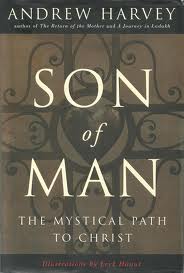
Son of Man: The Mystical Path to Christ, by Andrew Harvey, published in 1998 by Penguin/Putnam (ISBN o-87477-912-x).
The following are cover statements from the 1999 paperback edition.
“Already a treasured work of Christian mysticism, Son of Man is Andrew Harvey’s essential statement of Christ. Using the best of modern historical scholarship and the testimony of the greatest Christian mystics throughout the ages, Harvey revives the revolutionary promise of early Christianity and reveals Jesus as the Son of Man: a mystical radical whose aim was the initiation of all human beings into the power and splendor of their innate divinity, the overturning of all unjust hierarchies, and the transformation of Earth into the Kingdom of God.
“For the first time in any of his books, Harvey provides spiritual exercises—centuries-old rites previously available only to a few—that allow the reader direct experience with the mystical Christ. Son of Man also includes an easily accessible section or classic readings and meditations on the nature of Christ, making it the comprehensive experience in the Christ of the new millennium.
“Andrew Harvey is an acclaimed poet, novelist, mystical scholar, seeker, and teacher. He is the author of more than thirty books, including The Return of the Mother, The Way of Passion, A Celebration of Rumi, and the bestselling Hidden Journey.”
The following are cover statements from the 1999 paperback edition.
“Already a treasured work of Christian mysticism, Son of Man is Andrew Harvey’s essential statement of Christ. Using the best of modern historical scholarship and the testimony of the greatest Christian mystics throughout the ages, Harvey revives the revolutionary promise of early Christianity and reveals Jesus as the Son of Man: a mystical radical whose aim was the initiation of all human beings into the power and splendor of their innate divinity, the overturning of all unjust hierarchies, and the transformation of Earth into the Kingdom of God.
“For the first time in any of his books, Harvey provides spiritual exercises—centuries-old rites previously available only to a few—that allow the reader direct experience with the mystical Christ. Son of Man also includes an easily accessible section or classic readings and meditations on the nature of Christ, making it the comprehensive experience in the Christ of the new millennium.
“Andrew Harvey is an acclaimed poet, novelist, mystical scholar, seeker, and teacher. He is the author of more than thirty books, including The Return of the Mother, The Way of Passion, A Celebration of Rumi, and the bestselling Hidden Journey.”
Creating a Life with God, by Daniel Wolpert

"A LIFE WITH GOD is a life in which the rhythms of silence and listening alternate with the rhythms of sharing and service. By praying with every part of who we are, we allow the grace that pours from the will of living water to trickle through all the aspects of our being, nourishing and hydrating that which was parched and dis-eased. So begin the adventure, start the journey, follow Jesus. Allow God to transform your mind such that everything you are and everything you encounter speak with the breath of the Spirit...”
- Daniel Wolpert Creating a Life with God: The Call of Ancient Prayer Practices"
- Daniel Wolpert Creating a Life with God: The Call of Ancient Prayer Practices"
The Divine Hours
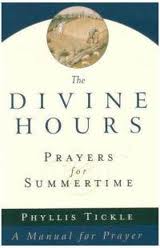
I start my morning prayer ritual reading from The Divine Hours; A Manual for Prayer, compiled by Phyllis Tickle. (There is also an online version http://www.explorefaith.org/prayer/fixed/hours.php) Tickle is an Episcopalian so it is not surprising that the liturgy that she has put together has the feel of The Book of Common Prayer.
There are three volumes. Prayers for Summertime, Prayers for Autumn and Wintertime, and Prayers for Springtime.
There are three volumes. Prayers for Summertime, Prayers for Autumn and Wintertime, and Prayers for Springtime.
Christ's Passion, Our Passions, by Margaret Bullitt-Jonas
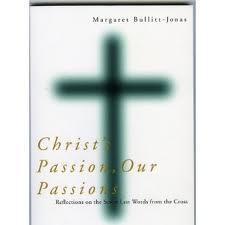
Christ's Passion, Our Passions: Reflections on the Seven
Last Words from the Cross. Margaret Bullitt-Jonas. Cowley Publications. 2002.
From the cover~
"Margaret Bullitt-Jonas not only takes us to the foot of the cross of Jesus, she invites us to consider the breadth of Christ’s healing, saving love for us, for those we love, and for the whole creation. Each reflection is followed by a series of prayer-provoking questions designed to draw us deeper into the mystery of extravagant generosity."
From the author~
"For generations, Christians have gathered at the cross of Christ to ponder his last words. We can probe Christ’s words in the same way we sometimes decipher the last words of our loved ones, testing their meaning, wondering what he intended to communicate. But we can also turn the exercise around, for in the end we come to the cross not to probe Christ’s words but to let them probe us—to let them work on our minds and hearts as we take our next step toward union with God."
Contents~
One “Father, forgive them for they know not
what they do.” Luke 23.32-38
Two “Today you will be with me in Paradise.”
Luke 23.19-43
Three “Woman, behold your son. Son, behold your
mother.” John 19.23-27
Four “My God, my God, why have you forsaken
me?” Matthew 27.45-49
Five “I thirst.” John 19.28-2
Six “It is finished.” John 19.30
Seven “Father, into your hands I commend my
spirit.” Luke 23. 46-49
From the cover~
"Margaret Bullitt-Jonas not only takes us to the foot of the cross of Jesus, she invites us to consider the breadth of Christ’s healing, saving love for us, for those we love, and for the whole creation. Each reflection is followed by a series of prayer-provoking questions designed to draw us deeper into the mystery of extravagant generosity."
From the author~
"For generations, Christians have gathered at the cross of Christ to ponder his last words. We can probe Christ’s words in the same way we sometimes decipher the last words of our loved ones, testing their meaning, wondering what he intended to communicate. But we can also turn the exercise around, for in the end we come to the cross not to probe Christ’s words but to let them probe us—to let them work on our minds and hearts as we take our next step toward union with God."
Contents~
One “Father, forgive them for they know not
what they do.” Luke 23.32-38
Two “Today you will be with me in Paradise.”
Luke 23.19-43
Three “Woman, behold your son. Son, behold your
mother.” John 19.23-27
Four “My God, my God, why have you forsaken
me?” Matthew 27.45-49
Five “I thirst.” John 19.28-2
Six “It is finished.” John 19.30
Seven “Father, into your hands I commend my
spirit.” Luke 23. 46-49
Lost in Wonder, by Ester de Waal

Lost in Wonder: Rediscovering the Spiritual
Art of Attentiveness. By Ester
de Waal. Liturgical Press. 2003.
Contents
1. The Starting Point
2. Seeing with the Inner Eye
3. Silence
4. Attention
5. Change
6. Dark and Light
7. Mystery
8. Gift
9. Epilogue
From Chapter One; The Starting Point~
“To take time to be apart, which I consciously give to myself as something positive, creative, is not a luxury, it is essential. The gift of space for myself seems so simple, and in a way it is; but it is also surprisingly difficult to do without some form of external encouragement. And that is the very simple purpose of this book.”
“Above all, I hope that this book will bring the opportunity to take time to clear and refresh the inner eye with which we see the world; and to think and pray about the balance between looking inward in self-interest and looking outward beyond the self to the world around.”
“As I change, so must my relationship with God….Above all it must never lose the element of mystery—and the recovery of mystery will be one of the most significant themes of what I am trying to explore in this book, just as attention, another of the themes of this book, which is generally applied to the physical world around us, also plays a vital role in keeping relationships alive.”
“Each chapter of this book ends with material for reflection which readers are encouraged to use in whatever way they please; quotations from Scripture, poems, short extracts, are all meant to lead into reflective, prayerful reading, silence. The inspiration fro this comes from the ancient monastic practice, applied to the reading of the Scriptures, known as lectio divina, which in its literal translation means ‘reading God’.”
“In the end it is prayer which allows me to hold everything else in place and which prevents me from being pulled apart, fragmented. The sense of the presence of God is the anchor, the linchpin, the rock, by which all the varied elements of daily life are brought into perspective. Everything flows in and out of prayer: it is as simple as that.”
“This retreat may not only give me the chance to think again about how I might carry this interior space within me but also how I might create a special physical place, however small, set apart as a touchstone or a point of reference, as it were, to which I can return in order to strengthen my commitment to silence and prayer. “
Contents
1. The Starting Point
2. Seeing with the Inner Eye
3. Silence
4. Attention
5. Change
6. Dark and Light
7. Mystery
8. Gift
9. Epilogue
From Chapter One; The Starting Point~
“To take time to be apart, which I consciously give to myself as something positive, creative, is not a luxury, it is essential. The gift of space for myself seems so simple, and in a way it is; but it is also surprisingly difficult to do without some form of external encouragement. And that is the very simple purpose of this book.”
“Above all, I hope that this book will bring the opportunity to take time to clear and refresh the inner eye with which we see the world; and to think and pray about the balance between looking inward in self-interest and looking outward beyond the self to the world around.”
“As I change, so must my relationship with God….Above all it must never lose the element of mystery—and the recovery of mystery will be one of the most significant themes of what I am trying to explore in this book, just as attention, another of the themes of this book, which is generally applied to the physical world around us, also plays a vital role in keeping relationships alive.”
“Each chapter of this book ends with material for reflection which readers are encouraged to use in whatever way they please; quotations from Scripture, poems, short extracts, are all meant to lead into reflective, prayerful reading, silence. The inspiration fro this comes from the ancient monastic practice, applied to the reading of the Scriptures, known as lectio divina, which in its literal translation means ‘reading God’.”
“In the end it is prayer which allows me to hold everything else in place and which prevents me from being pulled apart, fragmented. The sense of the presence of God is the anchor, the linchpin, the rock, by which all the varied elements of daily life are brought into perspective. Everything flows in and out of prayer: it is as simple as that.”
“This retreat may not only give me the chance to think again about how I might carry this interior space within me but also how I might create a special physical place, however small, set apart as a touchstone or a point of reference, as it were, to which I can return in order to strengthen my commitment to silence and prayer. “
The Way of a Pilgrim
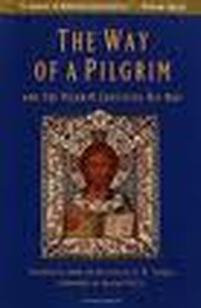
From the dust cover~
“A classic of Russian spirituality, The Way of a Pilgrim is an account of one man who sets out to learn the prayer of the heart, also know as the ‘Jesus Prayer’, and how the practice transforms his existence. Its anonymous author was one of the wandering pilgrims who were a regular feature of the Russian countryside from medieval times until the early 20th century. Through his eyes we are given a charming glimpse into rural life in nineteenth-century Russia and discover with him the secret of putting into practice St. Paul’s exhortation to ‘pray without ceasing’. “
Selected quotes~
“By the grace of God I am a Christian, by my actions a great sinner, and by calling a homeless wanderer of the simplest origins, traveling from place to place. My worldly belongs are a knapsack that contains some bread and a Bible in my breast pocket. That is all."
"Unceasing interior prayer is the constant striving of the spirit toward God."
"Many people treat prayer in an inverted way, thinking that it is one’s efforts and preparatory steps that give rise to prayer, rather than the prayer itself giving birth to good works and all the virtues."
"Consequently, the frequency and regularity of prayer are the only things that lie within our abilities, as the means of attaining to pure prayer, which is the mother of all blessings….First learn to pray and then you will easily perform good works."
"The unceasing interior prayer of Jesus is the uninterrupted, continual calling up the divine Name of Jesus Christ, with the lips, the mind, and the heart, while calling to mind His constant presence and beseeching His mercy, during any activity with which one may be occupied, in all places, at all time, and even while sleeping. The words of this prayer are as follows: “Lord Jesus Christ, have mercy on me!’"
“So I started reading the Philokalia (the anthology of Easter Orthodox writings on prayer)… first to seek the place of the heart, according to the teachings of Symeon the New Theologian. I closed my eyes and gazed mentally into my heart; I tried to visualize it in the left part of my chest cavity and carefully listened to its beating. I began doing this exercise for a half and hour several times a day. At first I saw only total darkness, but soon a picture of my heart, along with the sound of its natural beating, formed in my mind. Then I began to repeat the Jesus prayer in my heart in a steady rhythm in my breathing, as taught by St. Gregory of Sinai, Callistus, and Ignatius: namely by concentrating my mind in the heart while visualizing it in my mind, I inhaled saying, “Lord Jesus Christ,” and then exhaled saying, “Have mercy on me.” "